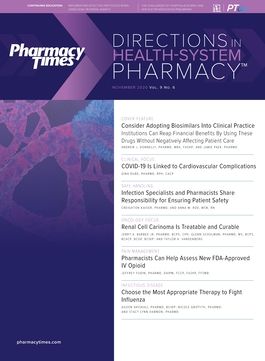Publication
Article
Pharmacy Practice in Focus: Health Systems
Choose the Most Appropriate Therapy to Fight Influenza
Author(s):
Baloxavir marboxil and oseltamivir are options for treating uncomplicated influenza.
Just as each influenza season is different, the effectiveness of annual influenza vaccines is never the same from year to year.
Influenza vaccine components are chosen each year based on the predicted predominant strains.1 Since the choices are made based on predictions, no vaccine reaches 100% effectiveness in preventing seasonal influenza. A vaccine effectiveness of 19% to 60% is historically consistent.2
The Centers for Disease Control and Prevention (CDC) reported an early start to the 2019-2020 influenza season during the week of November 9, 2019.2 Influenza B predominated early in the season, with influenza A cases increasing during the remainder of the season. The US Influenza Vaccine Effectiveness Network assessed patients aged 6 months or older who were seen for respiratory illness in the outpatient setting across 5 study sites.3 As of February 2020, among 6879 patients who tested positive for influenza, 37% had received an influenza vaccine. Vaccine effectiveness was 50% against influenza B, 37% against influenza A, and 45% for both types combined.
Baloxavir Marboxil Versus Oseltamivir
Baloxavir marboxil (Xofluza) and oseltamivir (Tamiflu) are oral antiinfluenza therapies available in the United States. When deciding which agent to use, it is important to consider their differences, including cost, dosing, indications and populations approved by the United States Food and Drug Administration (FDA), and mechanism of action.
Mechanistically, these drugs attack different targets. Baloxavir marboxil inhibits the endonuclease activity of the polymerase acidic protein, thus inhibiting viral replication, whereas oseltamivir inhibits neuraminidase, which affects the release of viral particles.4,5
Oral oseltamivir is widely used as firstline therapy for the treatment of influenza in clinical practice.6 Baloxavir marboxil received FDA approval after the finalization of the 2018 guidelines, and thus specific recommendations for use were not included. Preliminary 2020-2021 CDC recommendations suggest oseltamivir for hospitalized patients but give equal weight to oseltamivir and baloxavir marboxil for outpatient treatment.7 In addition to the treatment of influenza, oseltamivir is approved for prophylaxis of influenzas A and B. Oseltamivir is approved in patients older than 2 weeks compared with patients older than 12 years with baloxavir marboxil. Although baloxavir marboxil has been used in patients younger than 12 years in some recent studies, additional safety and efficacy data are needed to better define use in this population.8 Although both agents should be initiated within 48 hours of symptom onset, baloxavir marboxil’s long half-life allows a single-dose regimen compared with the 5-day, twice-daily regimen with oseltamivir.4,5 Adherence to a single pill regimen is certainly an advantage of baloxavir marboxil, but cost is a potentially significant barrier. A single adult-dose of brand-name Xofluza costs about 3 times more than a 5-day course of generic oseltamivir.9,10
Although there is less clinical experience with baloxavir marboxil, because of its recent approval, multiple controlled randomized studies comparing baloxavir marboxil with oseltamivir and a placebo supported its FDA approval. The CAPSTONE I study (NCT02954354)11 included otherwise healthy outpatients with acute uncomplicated influenza in Japan and the United States. In the full cohort, baloxavir marboxil reduced the median time to alleviation of symptoms by 26.5 hours compared with the placebo (P < .001) but found no difference compared with oseltamivir. The CAPSTONE II study (NCT02949011)12 included patients with at least 1 high-risk medical condition and uncomplicated influenza. As in the CAPSTONE I study, a single dose of baloxavir marboxil was found to reduce the median time to improvement of symptoms by 291 hours compared with the placebo (P < .0001) but was not significantly different compared with oseltamivir. However, in the influenza B subset, baloxavir marboxil reduced the median time to symptom improvement by 27 hours compared with oseltamivir (P < .0251).
Finally, another recent study suggested that baloxavir marboxil also may be effective for prophylaxis of household contacts. Clinical influenza development was significantly lower in a group treated with a single, weight-based dose of baloxavir marboxil after household exposure to influenza compared with the placebo in a controlled, double-blind, randomized trial (1.9% baloxavir marboxil versus 13.6% placebo, P < .001).9
A final therapeutic consideration pertains to emerging baloxavir marboxil resistance. In 1 study, emergence of viruses with PA/I38X substitution following baloxavir marboxil treatment was associated with a delay in symptom alleviation and, uncommonly, symptom rebound.13 Further study is warranted to better define the risk of posttreatment resistance and potential methods to circumvent it.
Baloxavir marboxil and oseltamivir are both potential options for treating uncomplicated influenza. Treatment decisions should be made on a case-by-case basis for the 2020-2021 influenza season. Oseltamivir is the preferred option for children younger than 12 years. However, emerging data suggest that baloxavir may be efficacious and safe in younger children as well. Patients with adherence barriers to multiple-day dosing may benefit from baloxavir marboxil over oseltamivir, as it is available as a single dose. However, patients with cost barriers may prefer oseltamivir, given the significant cost difference between the 2 agents.
Aileen Ahiskali, PharmD, BCIDP, is an antimicrobial stewardship pharmacist at Hennepin County Medical Center in Minneapolis, Minnesota.Nicole Griffith, PharmD, is a PGY1 resident at the University of Virginia Health System in Charlottesville, Virginia.Stacy Lynn Harmon, PharmD, is an antimicrobial stewardship clinical pharmacy specialist at SCL Health in Grand Junction, Colorado.
REFERENCES
- Grohskopf LA, Alyanak E, Broder KR, Walter EB, Fry AM, Jernigan DB. Prevention and control of seasonal influenza with vaccines: recommendations of the Advisory Committee on Immunization Practices — United States, 2019-20 influenza season. MMWR Recomm Rep. 2019;68(3):1-24. doi:10.15585/mmwr. rr6908a1
- Dawood FS, Chung JR, Kim SS, et al. Interim estimates of 2019-20 seasonal influenza vaccine effectiveness — United States, February 2020. MMWR Morb Mortal Wkly Rep. 2020;69:177-182. doi:10.15585/mmwr.mm6907a1
- Jackson ML, Chung JR, Jackson LA, et al. Influenza vaccine effectiveness in the United States during the 2015—2016 season. N Engl J Med. 2017;377:534- 543. doi:10.1056/NEJMoa1700153
- Tamiflu. Prescribing information. Gilead Sciences Inc; 2012. https://www. accessdata.fda.gov/drugsatfda_docs/label/2012/021087s062lbl.pdf
- Xofluza. Prescribing information. Shionogi & Co Ltd; 2018. https://www. accessdata.fda.gov/drugsatfda_docs/label/2018/210854s000lbl.pdf
- Uyeki TM, Bernstein HH, Bradley JS, et al. Clinical practice guidelines by the Infectious Diseases Society of America: 2018 update on diagnosis, treatment, chemoprophylaxis, and institutional outbreak management of seasonal influenza. Clin Infect Dis. 2019;68(6):e1-47. doi:10.1093/cid/ciy866
- CDC. Influenza antiviral medications: summary for clinicians. Updated October 26, 2020. Accessed October 29, 2020. https://www.cdc.gov/flu/professionals/ antivirals/summary-clinicians.htm#:~:text=The%20recommended%20 treatment%20course%20for,oral%20baloxavir%20for%201%20day
- Ikematsu H, Hayden FG, Kawaguchi K, et al. Baloxavir marboxil for prophylaxis against influenza in household contacts. N Engl J Med. 2020;383(4):309- 320. doi:10.1056/NEJMoa1915341
- Xofluza. GoodRx. Accessed June 16, 2020. https://www.goodrx.com/xofluza
- Tamiflu. GoodRx. Accessed October 27, 2020. https://www.goodrx.com/ tamiflu
- Hayden FG, Sugaya N, Hirotsu N, et al. Baloxavir marboxil for uncomplicated influenza in adults and adolescents. N Engl J Med. 2018;379:913- 923. doi:10.1056/NEJMoa1716197
- Ison MG, Portsmouth S, Yoshida Y, et al. Early treatment with baloxavir marboxil in high-risk adolescent and adult outpatients with uncomplicated influenza (CAPSTONE-2): a randomised, placebo-controlled, phase 3 trial. Lancet Infect Dis. 2020;20(10):1204-1214. doi:10.1016/S1473-3099(20)30004-9
- Uehara T, Hayden FG, Kawaguchi K, et al. Treatment-emergent influenza variant viruses with reduced baloxavir susceptibility: impact on clinical and virologic outcomes in uncomplicated influenza. J Infect Dis. 2020;221(3):346-355. doi:10.1093/infdis/jiz244
The Society of Infectious Diseases Pharmacists (SIDP) is an association of pharmacists and other allied healthcare professionals who are committed to promoting the appropriate use of antimicrobial agents and supporting practice, teaching, and research in infectious diseases. We aim to advance infectious diseases pharmacy and lead antimicrobial stewardship in order to optimize the care of patients. To learn more about SIDP, visit sidp.org.







